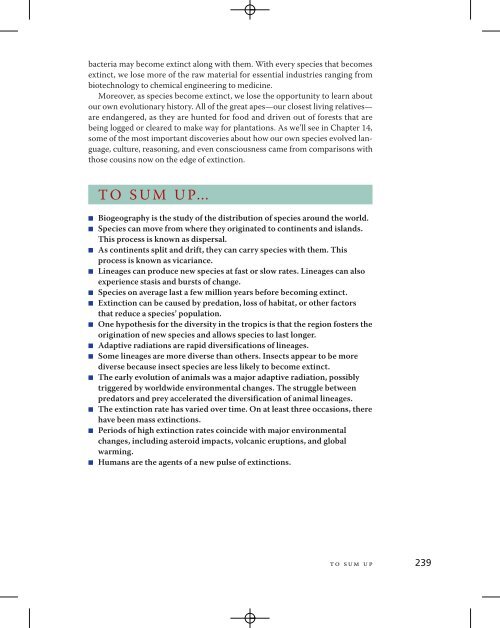Reprinted from The Tangled Bank: An Introduction to Evolution by ...
Reprinted from The Tangled Bank: An Introduction to Evolution by ...
Reprinted from The Tangled Bank: An Introduction to Evolution by ...
Create successful ePaper yourself
Turn your PDF publications into a flip-book with our unique Google optimized e-Paper software.
acteria may become extinct along with them. With every species that becomes<br />
extinct, we lose more of the raw material for essential industries ranging <strong>from</strong><br />
biotechnology <strong>to</strong> chemical engineering <strong>to</strong> medicine.<br />
Moreover, as species become extinct, we lose the opportunity <strong>to</strong> learn about<br />
our own evolutionary his<strong>to</strong>ry. All of the great apes—our closest living relatives—<br />
are endangered, as they are hunted for food and driven out of forests that are<br />
being logged or cleared <strong>to</strong> make way for plantations. As we’ll see in Chapter 14,<br />
some of the most important discoveries about how our own species evolved language,<br />
culture, reasoning, and even consciousness came <strong>from</strong> comparisons with<br />
those cousins now on the edge of extinction.<br />
TO SUM UP…<br />
■ Biogeography is the study of the distribution of species around the world.<br />
■ Species can move <strong>from</strong> where they originated <strong>to</strong> continents and islands.<br />
This process is known as dispersal.<br />
■ As continents split and drift, they can carry species with them. This<br />
process is known as vicariance.<br />
■ Lineages can produce new species at fast or slow rates. Lineages can also<br />
experience stasis and bursts of change.<br />
■ Species on average last a few million years before becoming extinct.<br />
■ Extinction can be caused <strong>by</strong> predation, loss of habitat, or other fac<strong>to</strong>rs<br />
that reduce a species’ population.<br />
■ One hypothesis for the diversity in the tropics is that the region fosters the<br />
origination of new species and allows species <strong>to</strong> last longer.<br />
■ Adaptive radiations are rapid diversifications of lineages.<br />
■ Some lineages are more diverse than others. Insects appear <strong>to</strong> be more<br />
diverse because insect species are less likely <strong>to</strong> become extinct.<br />
■ <strong>The</strong> early evolution of animals was a major adaptive radiation, possibly<br />
triggered <strong>by</strong> worldwide environmental changes. <strong>The</strong> struggle between<br />
preda<strong>to</strong>rs and prey accelerated the diversification of animal lineages.<br />
■ <strong>The</strong> extinction rate has varied over time. On at least three occasions, there<br />
have been mass extinctions.<br />
■ Periods of high extinction rates coincide with major environmental<br />
changes, including asteroid impacts, volcanic eruptions, and global<br />
warming.<br />
■ Humans are the agents of a new pulse of extinctions.<br />
<strong>to</strong> sum up 239

















